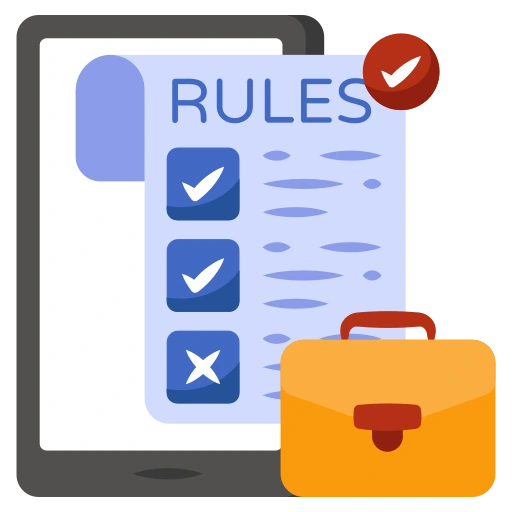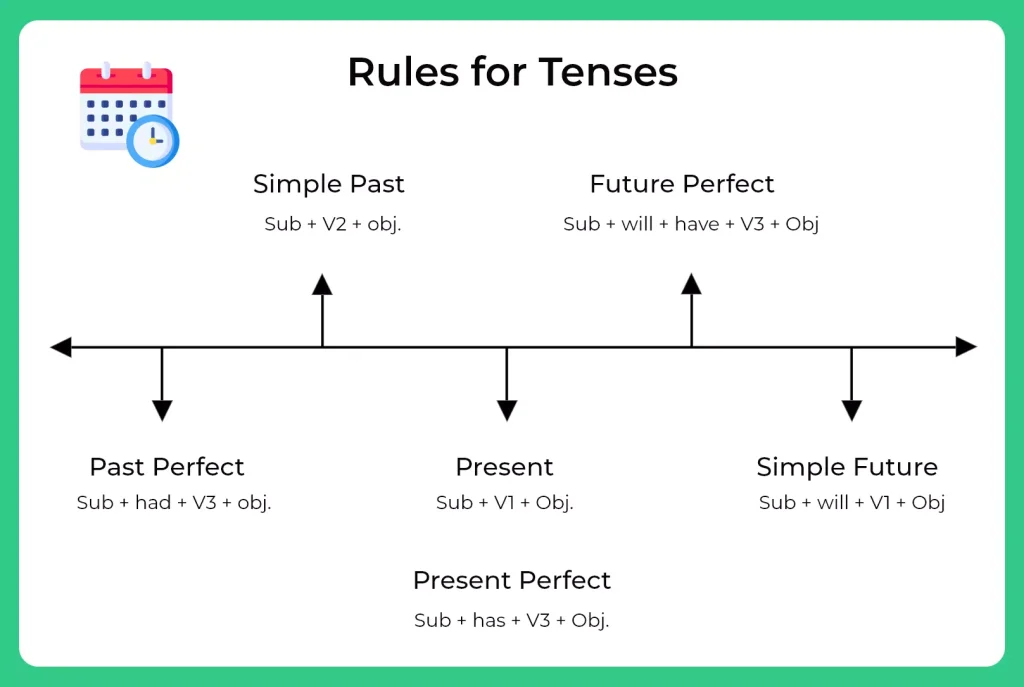Verbal Menu
- Basic Grammar
- Speech and Voices
- Tenses
- Articles
- Tenses and Articles
- Idioms and Phrases
- Subject Verb Agreement
- Prepositions and Conjunction
- Selecting Words
- Relative Pronoun
- Sentence Completion
- Sentence Ordering
- Contextual Vocabulary
- Jumbled Sentence
- Sentence Formation
- Error Identification
- Sentence Improvement and Construction
- Cloze Test
- Fill in the blanks
- Paragraph Ordering
- Para Jumbles
- Synonyms and Antonyms
- Synonyms
- Antonyms
- Reading Comprehension
- Get Off-campus Drive Updates
- Get Hiring Updates
- Contact US
PREPINSTA PRIME
Rules For Tenses
Rules for Tenses
Rules For Tenses is one of the most important rules in English Grammar. Tenses are form of verb that reflects the time of action happened or happening or will happen. Tenses are generally divided into three forms:
- Present
- Past
- Future.
However, they comprise sub-sections to describe the precise time of action. Rules of Tenses aid a student to understand how to use different tenses in a sentence accurately, without making a grammatical error.
On this page we’ll see Rules For Tenses. Let’s take a look at the different tense forms and their bifurcations.

Rules For Tenses
Tenses |
Rules for Tenses |
|---|---|
| Past Simple Tenses | Subject + V2 + Object |
| Past Perfect Tense | Subject + had + V3 + Object |
| Past Continuous Tenses | Subject + was + V1 + ing + Object (Singular) Subject + were + V1 + ing + Object (Plural) |
| Past Perfect Continuous Tense | Subject + had been + V1 + ing + Object |
| Present Simple Tenses | Subject + V1 + s/es + Object (Singular) Subject + V1 + object (Plural) |
| Present Perfect Tense | Subject + has + V3 + Object (Singular) Subject + have + V3 + Object (Plural) |
| Present Continuous Tenses | Subject + is/am/are + V1 + ing + object |
| Present Perfect Continuous Tense | Subject + has been + V1 + ing + Object (Singular) Subject + have been + V1 + ing + Object (Plural) |
| Future Simple Tenses | Subject + will/shall + V1 + Object |
| Future Perfect Tense | Subject + will have/shall have + V3 + Object |
| Future Continuous Tenses | Subject + will be/shall be + V1 + ing + Object |
| Future Perfect Continuous Tense | Subject + will have been + V1 + ing + Object |

Forms and Rules For Tenses
Let’s discuss in details about their rules for each tense and sight examples for each.
Prime Course Trailer
Related Banners
Get PrepInsta Prime & get Access to all 200+ courses offered by PrepInsta in One Subscription
Rules For Tenses - Simple Tense
Present Tense
Singular:
Rule – Subject + V1 + s/es + Object
Example – The child plays a guitar.
(Here the subject Child is singular ans so we use ‘s’ with the verb ‘play’)
Plural:
Rule: Subject + V1 + object
Example – The children play guitar.
(Here the subject Children is plural and we use the plural form of the verb ‘play’ without an ‘s’)
Past Tense
Rule – Subject + V2 + Object
For past tense, the verb is always plural irrespective of the subject. (without an ‘s’.)
Example – He / They swam across the river.
(Here, the subject “he” and “they” is followed by “swam” , the second form of verb (V2) of “swim”)
Future Tense
Rule: Subject + will/shall + V1 + Object
For future tense, the verb is always plural irrespective of the subject. (without an ‘s’.)
Example – I shall go to the market tomorrow.
(In this example, the subject “I” + shall is followed by the first form of verb (V1) “go”.)
Rules for Tenses - Continuous Tense
Present Tense
Rule: Subject + is/am/are + V1 + ing + object
While employing the tense rules for present continuous, all the verb form for singular or plural subject stays in its first form V1
Example: Mary is dancing / They are dancing
Here the subject “Mary” or “they” is followed by ‘is’ or ‘are’ respectivly. The first form of verb (V1) here is “dance” and we added “ing” to it to make it continuous.
Past Tense
Singular
Rule – Subject + was + V1 + ing + Object
Example – Mary was cleaning the house
Here, the subject “Mary” + ‘was’ is followed by the first form of verb (V1) “clean” + “ing”
Plural
Rule: Subject + were + V1 + ing + Object
Example: They were cleaning the house
Here, the subject is “They” + were is followed by the first form of verb (V1) “clean” + “ing”
Future Tense
Rule: Subject + will be/shall be + V1 + ing + Object
Example – Mary / They will be coming to my house tomorrow
Here the subject “Mary” / “They” + will be is followed by the first form of verb (V1) “come”+ing
Rules for Tenses - Perfect Tense
Present Tense
Singular
Rule: Subject + has + V3 + Object
Example: Mary has washed the clothes
Here, “Mary” is the subject + has “washed” followed by the third form of verb “wash”
Plural:
Rule – Subject + have + V3 + Object
Example – They have washed the clothes
Here, “They” is the subject + have followed by the third form of verb “wash”
Past Tense
Rule – Subject + had + V3 + Object
Example – Mary had pulled the rope
Here the subject “Mary” + had is followed by the third form of verb (V3) “pull”.
Future Tense
Rule: Subject + will have/shall have + V3 + Object
Example – Mary shall have covered all the notebooks in brown paper by tomorrow.
Here, the subject is “Mary” + shall have is followed by the third form of Verb (V3) “covered”
Rules for Tenses - Perfect Continuous Tense
Present Tense
Singular:
Rule – Subject + has been + V1 + ing + Object
Example – Mary has been studying since morning
Here, the subject “Mary” + has been is followed the the first form of verb “study” + ing
Plural:
Rule: Subject + have been + V1 + ing + Object
Example – The students have been studying since morning
Here the subject “students” + have been is followed by the first form of verb “study” + ing
Past Tense
Rule – Subject + had been + V1 + ing + Object
Example – Mary had been taking care of her mother from last two weeks.
Here the subject “Mary” + had been is followed the first form of verb (V1) of “take” + ing
Future Tense
Rule – Subject + will have been + V1 + ing + Object
Example – He shall have been living here since 2001
Here, the subject “he” + will have been is followed by the first form of verb “work”+ing
Sample Questions
Choose the correct form of tenses and fill in the blank.
Question: 1
“She _______ at that company for five years before she got promoted.”
Options:
- worked
- has been working
- works
- will work
Explanation:
The correct answer is ‘worked’.
This sentence is in the past simple tense to indicate an action that occurred and was completed in the past.
Rule for simple past tense: Subject + V2 + Object
Question: 2
Choose the correct verb tense to complete the sentence:
“By the time we arrive, they _______ the party.”
Options:
- started
- will have started
- start
- have started
Explanation:
The correct answer is ‘will have started’.
This sentence is in the future perfect tense to indicate that an action will be completed before a certain point in the future.
Rule for future perfect tense: Subject + will have/shall have + V3 + Object
Question: 3
Fill in the blank with the appropriate verb tense:
“I can’t believe he _______ that song for over an hour!”
Options:
- sings
- has been singing
- sang
- will sing
Explanation:
The correct answer is ‘has been singing.’
This sentence is in the present perfect continuous tense to describe an action that started in the past, continued in the present, and may still be ongoing.
Rule for present perfect continuous tense: Subject + has been + V1 + ing + Object
Also Check Out
Also Check:
- Basic Grammar – Questions | Rules | How to Solve Quickly | Tricks & Shortcuts
- Speech and Voices – Questions | Rules | How to Solve Quickly | Tricks & Shortcuts
- Tenses – Questions | Rules | How to Solve Quickly | Tricks & Shortcuts
- Tenses and Articles – Questions | Rules | How to Solve Quickly | Tricks & Shortcuts
- Idioms and Phrases – Questions | Rules | How to Solve Quickly | Tricks & Shortcuts
- Subject Verb Agreement – Questions | Rules | How to Solve Quickly | Tricks & Shortcuts
- Prepositions and Conjunction – Questions | Rules | How to Solve Quickly | Tricks & Shortcuts
- Selecting Words – Questions | Rules | How to Solve Quickly | Tricks & Shortcuts
- Relative Pronoun – Questions | Rules | How to Solve Quickly | Tricks & Shortcuts
- Sentence Completion- Questions | Rules | How to Solve Quickly | Tricks & Shortcuts
- Basic Grammar –
Questions
Rules
How to Solve Quickly
Tricks & Shortcuts - Speech and Voices
Questions
Rules
How to Solve Quickly
Tricks & Shortcuts - Tenses
Questions
Rules
How to Solve Quickly
Tricks & Shortcuts - Tenses and Articles
Questions
Rules
How to Solve Quickly
Tricks & Shortcuts - Idioms and Phrases
Questions
Rules
How to Solve Quickly
Tricks & Shortcuts - Subject Verb Agreement
Questions
Rules
How to Solve Quickly
Tricks & Shortcuts - Prepositions and Conjunction
Questions
Rules
How to Solve Quickly
Tricks & Shortcuts - Selecting Words
Questions
Rules
How to Solve Quickly
Tricks & Shortcuts - Relative Pronoun
Questions
Rules
How to Solve Quickly
Tricks & Shortcuts - Sentence Completion
Questions
Rules
How to Solve Quickly
Tricks & Shortcuts
Get over 200+ course One Subscription
Courses like AI/ML, Cloud Computing, Ethical Hacking, C, C++, Java, Python, DSA (All Languages), Competitive Coding (All Languages), TCS, Infosys, Wipro, Amazon, DBMS, SQL and others

 Apply For Jobs
Apply For Jobs Get Hiring Updates
Get Hiring Updates




Login/Signup to comment